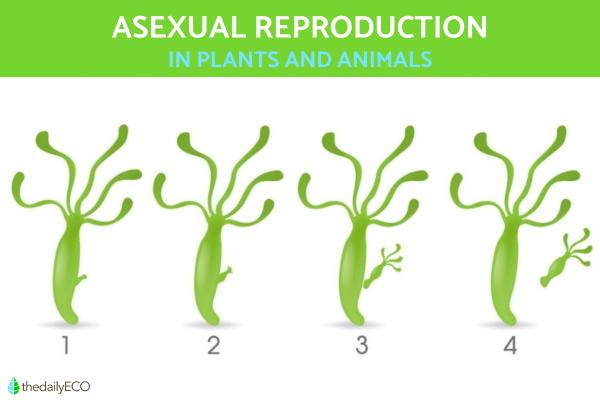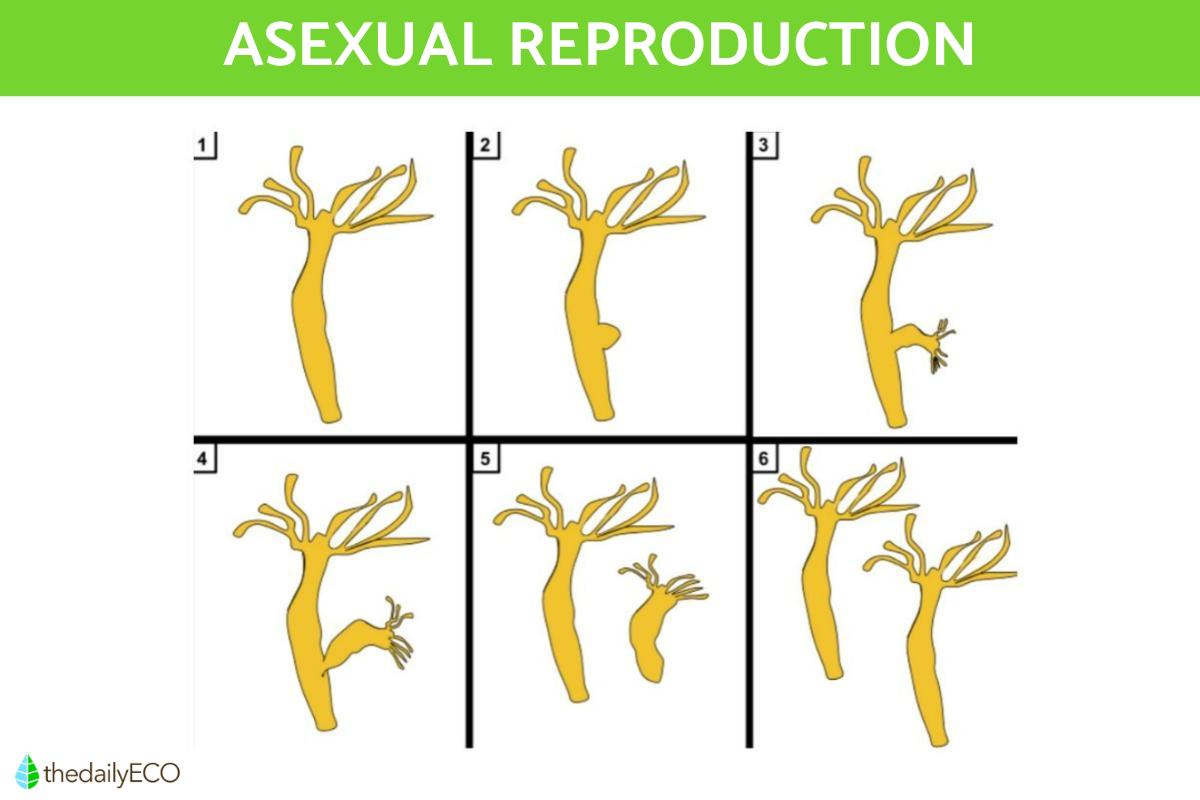Asexual Reproduction in Plants and Animals


All living things are capable of reproduction. It is carried out as an evolutionary ability to continue their species. While the act of reproduction is universal, how it is carried out is much more varied than you may think. New organisms are known as offspring which result from the parent organism. We may think of parents and offspring in the limited confines of animals, but plant reproduction requires the same process. Since humans reproduce sexually, we may think of it as the most normal. However, different species have adapted various strategies to maintain their lines. This adaptation may require another member of their species, but some are able do do it on their own.
At thedailyECO, we look at asexual reproduction in plants and animals, one of the two forms of reproduction. We provide a suitable definition of asexual reproduction, as well as examples of it in nature.
What is asexual reproduction in plants and animals?
The definition of asexual reproduction is the physiological process that allows living organisms to transmit their genetic information to their descendants without the union of gametes. This union occurs between individuals of different sex to produce their offspring. We may only think of animals being able to reproduce sexually, but similar basic functions are also carried out in plant species of all kinds.
Asexual reproduction is a much simpler and faster process than sexual reproduction. Since there is no fusion between gametes as in sexual reproduction between two members of a species, the number of chromosomes does not change. Although both single-celled and multicellular organisms can carry out asexual reproduction, it is more common in unicellular organisms. These include bacteria and other microorganisms.

Characteristics of asexual reproduction
Asexual reproduction is carried out in a variety of unicellular and multicellular species. However, there are certain aspects which are common in all examples of asexual reproduction. The following are the main characteristics of asexual reproduction:
- In asexual reproduction there is only one parent.
- The cells involved in asexual reproduction are somatic (not sexual) cells, which reproduce by mitosis (as opposed to the meiosis that characterizes the sexual reproduction of gametes).
- The genetic information of the new organisms generated by asexual reproduction is identical to that of its parent.
- There is no exchange of genetic information during asexual reproduction, so the variability of new organisms is due solely and exclusively to possible mutations.
- Through asexual reproduction, organisms manage to save large amounts of energy and are able to survive to better guarantee the extension and perpetuation of their species. This is carried out in a more direct way than if they did so through sexual reproduction.
Types of asexual reproduction
Now that we know what is asexual reproduction and its main characteristics, we should know there are different types of asexual reproduction in nature. The reason some plants and animals reproduce asexually is because evolution has afforded them the ability in order to survive. They have adapted different ways according to habitat, circumstance and other reasons, many of which we are yet to fully understand.
Sporulation
This type of asexual reproduction occurs mainly in unicellular organisms such as bacteria and fungi. Under adverse environmental conditions such as excessive temperatures or being located somewhere with a lack of nutrients, they are capable of reproducing by creating spores. These act as resistant structures that will be capable of surviving in such unfavorable conditions.
Budding
By forming a gem-like structure (or yolk) in the parent organism (both unicellular and multicellular), a new, usually smaller organism is created by duplication. It is also known alternatively as gemmation or blastogenesis.
Binary fission
Also known as bipartition, the organism forms a septum-like structure in the cell membrane. Essentially, it divides in two to produce genetically identical organisms. Many prokaryotic cellular organisms use this type of fission to give rise to new organisms. Some eukaryotes (organisms with cells which have a nucleus) may produce in this way via mitosis, i.e. cell division.
Fragmentation or segmentation
This amazing mechanism of asexual reproduction is based on the ability of the parent organism to fragment one or several parts of its anatomical structure. Once this occurs, the new individual will grow from the newly fragmentated part. These organisms are also capable of regenerating their own structures. This mechanism is characteristic of both some plants and certain animals, such as sea urchins and starfish.
Parthenogenesis
This strange phenomenon of asexual reproduction allows some animals to reproduce asexually when there are no nearby individuals of the opposite sex to reproduce sexually. These animals generate diploid eggs through mitosis and it is characteristic of many invertebrates (crustaceans, flatworms, rotifers, cladocerans), as well as some vertebrates (amphibians, reptiles, fish and even birds on certain occasions). It is the most common type of asexal reproduction in vertebrates.
Examples of asexual reproduction in plants
Asexual reproduction in plants is also commonly known as vegetative reproduction. This process allows plants to reproduce through structures other than seeds, such as stems (cuttings, grafts), leaves, buds, and even roots (tubers, rhizomes, bulbs).
In the following list we will see some examples of plants which reproduce asexually. This type of asexual reproduction in plants can occur naturally. However, some species have been adapted by humans to do so. The latter is mainly for agricultural purposes to improve crop yield..
Examples of plants with natural asexual reproduction
- Ferns
- Mosses
- Unicellular algae (e.g. Euglena spp.)
Examples of plants with artificial asexual reproduction
- Strawberries (aerial runner modifications)
- Sorghum (rhizome modifications)
- Orange trees (cuttings)
Examples of asexual Reproduction in animals
Some vertebrate animals are capable of reproducing asexually, but it is much more common invertebrate animals. Animal asexual reproduction is sometimes a complementary to sexual reproduction. In these cases, they often use it as a preferred option in adverse survival conditions. For other animals it is their usual reproduction process.
In the following list, we can see examples of animals that reproduce asexually. As we can see, they include various types of animal species, all of which are multicellular. Unicellular organisms are not considered animals. They include cnidarians, fish, reptiles and others:
- Jellyfish
- Anemones
- Corals
- Sea sponges
- Nematodes
- Cladocera
- Starfish (genus Linckia)
- Mollusks (e.g. Tarebia granifera or quilted melania)
- Fish (e.g. Sphyrna mokarran or great hammerhead shark)
- Reptiles (e.g. Heteronotia binoei or Bynoe's gecko)
The asexual reproduction which occurs in certain reptiles such as the New Mexico whiptail (Aspidoscelis neomexicanus) occurs through parthenogenesis, as is common to vertebrates. However, females of the species do carry out mating behavior with other females. It is not known exactly why, but it is thought to induce ovulation for asexual reproduction.
If you want to read similar articles to Asexual Reproduction in Plants and Animals, we recommend you visit our Biology category.
- Vallejo-Marín, M. (2014) The correlation between polyploidy and asexual reproduction. Ecosystems, Scientific Journal of Ecology and Environment. Volume 23 (3), pp: 78-82.
- Jordana, R. & Herrera-Mesa, L. (1974) Sexual reproduction in animals. Person and Law Magazine. Volume 1, pp: 409-434.






